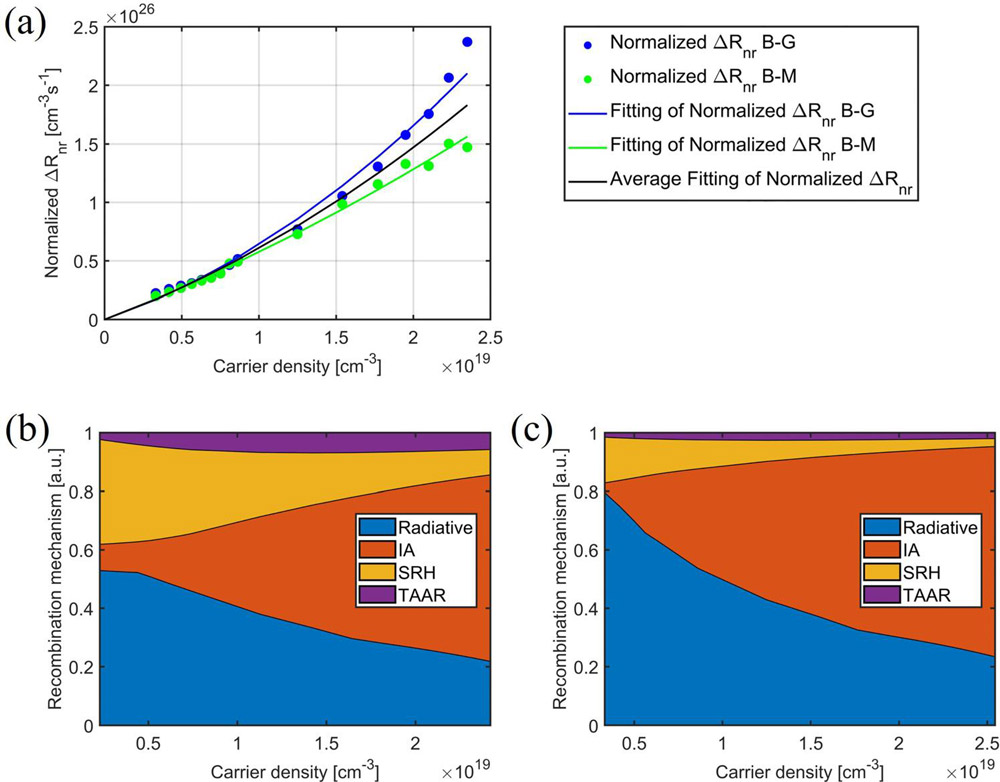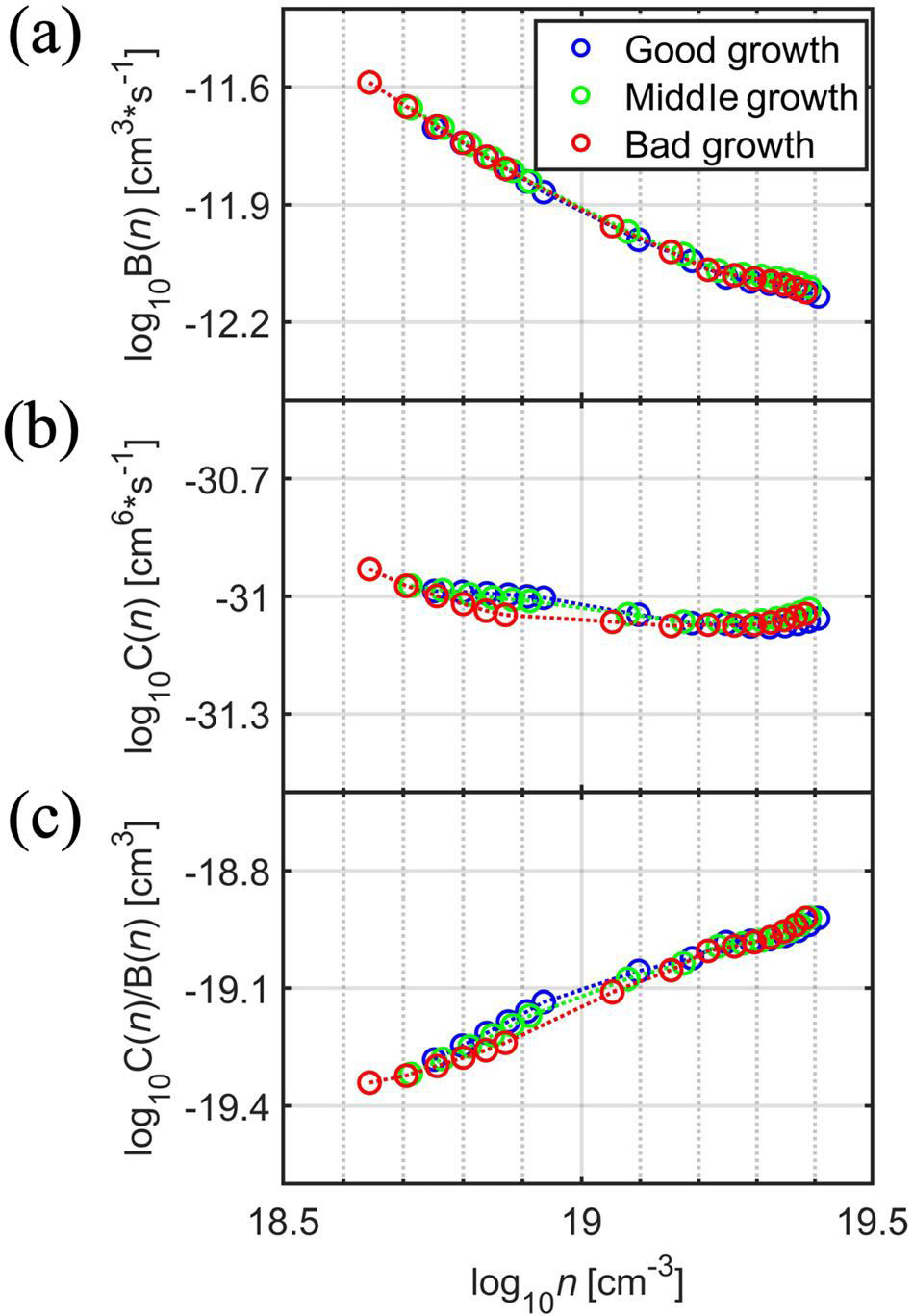News: LEDs
5 October 2023
Determining droop in green InGaN LEDs
Researchers based in the USA report that “intrinsic Auger–Meitner recombination was found to be the primary mechanism for non-radiative recombination” in green indium gallium nitride (InGaN) light-emitting diodes (LEDs), according to their experimental studies [Xuefeng Li et al, Appl. Phys. Lett., v123, p112109, 2023].
The team from University of New Mexico, Lumileds LLC and Sandia National Laboratories in the USA comment: “The efficiency droop can be attributed to the imbalance between radiative and intrinsic Auger–Meitner recombination due to carrier localization and Coulomb enhancement in the LEDs studied. Thus, maintaining a low carrier density in thin QWs is advantageous for avoiding strong intrinsic Auger–Meitner recombination and utilizing the interplay of carrier localization and Coulomb enhancement on the radiative process.”
The Auger–Meitner mechanism is also often referred to as just Auger recombination. Although Lise Meitner reported the effect in 1922 as a by-product of other research, Pierre Victor Auger independently discovered and studied the mechanism more deeply, documenting his work in 1923.
The New Mexico/Lumileds/Sandia researchers studied samples with identical active regions but different deep-level defect densities. The active regions consisted of three 3nm InGaN quantum wells (QWs) with 19% indium content, targeting green emissions, separated by 18nm GaN barriers. The samples were grown using c-plane metal-organic chemical vapor deposition. The measured defect densities were 0.45x, 0.78x and 1.5x1015/cm3, according to deep-level optical spectroscopy (DLOS) and lighted capacitance–voltage (LCV) measurements.
The team describes DLOS as “a photo-capacitance technique that measures the optical absorption spectrum of a deep level from the time-dependence of change in space-charge in a depletion region when the defect changes charge state upon photo-emission.” The researchers also explain: “LCV compares C–V measurements taken in the dark with the deep level occupied and under 2.1eV illumination with the deep level optically depopulated.”
From the defect density values the rates of Shockley–Read–Hall (SRH) and trap-assisted Auger–Meitner (TAAR) recombination could be estimated.
Small-signal electroluminescence (SSEL) was used in combination with internal quantum efficiency (IQE) measurements to separate the radiative and non-radiative recombination rates. The IQE was determined at Lumileds’ facility using external quantum efficiency (EQE) measurements from LEDs fabricated from the three materials. The LEDs had a known light extraction efficiency, allowing the IQE to be calculated.
The researchers explain: “In SSEL, the total recombination lifetime can be calculated from the integration of the differential recombination lifetime, which is directly acquired from the simultaneous fitting of the impedance and modulation responses of the LED.”
The non-radiative recombination was assumed to consist of SRH, TAAR and intrinsic Auger (IA) recombinations. The SRH was assumed to be linear in carrier concentration (∝n), the TAAR to be quadratic (∝n2) and the IA to be the remainder (C(n)n3). Further, the SRH and TAAR were assumed to have linear dependence on defect density.
The differences between the non-radiative recombination rates ( ΔRnr) were normalized to a difference of 1x1015/cm3 in defect density and compared (Figure 1). The experimental data show good overlap between the good- (low defect density) and middle-quality samples relative to the bad sample at low carrier density.

Figure 1: (a) Normalized ΔRnr data and fitting versus carrier density for bad to good (B–G) and bad to middle (B–M) growth: solid dots experimental data, solid lines fits to data. (b, c) Percentages of recombination mechanisms versus carrier density in bad and good growth wafer, respectively.
The SRH and TAAR components of the non-radiative recombination coefficients were determined using quadratic fitting to the data and using the relevant defect density. The researchers point out that, while experimental and theoretical studies tend to assume a purely quadratic dependence of TAAR, “we still cannot completely exclude the possibility of an n3 dependency.”
The TAAR percentages remained below 7% and 3% for the bad and good materials, respectively. “In the samples studied, intrinsic Auger–Meitner recombination still dominates the non-radiative recombination and TAAR is not found to be a significant contributor to droop or the green gap,” the team comments.
Having separated out the non-radiative components, the researchers could determine (Figure 2) the coefficients for bimolecular (electron–hole) recombination into photons (B(n)) and for the intrinsic Auger rate (C(n)) as functions of carrier concentration. The B(n) values match closely for the different quality samples. Also, the C(n) trends are fairly comparable.

Figure 2: (a)–(c) B(n) and C(n) coefficients and the ratios of C(n)/B(n) versus carrier density for good, middle and bad growth.
The researchers comment: “The fact that all the B(n) coefficients are the same confirms the accuracy of using SSEL to measure the carrier dynamics since the three samples all have different IQEs and lifetimes. In thin quantum wells, B(n) and C(n) are influenced by several mechanisms, including the quantum-confined Stark effect (QCSE), phase-space filling effect (PSF), carrier localization, and Coulomb enhancement. QCSE and PSF have a similar effect on both radiative and non-radiative recombination rates. Carrier localization increases both radiative and intrinsic Auger–Meitner recombination rates but has more of an impact on intrinsic Auger–Meitner recombination.”
As a reminder, the total recombination is decomposed as:
An + B(n)n2 + C(n)n3 + Dn2
The A and D coefficients represent, respectively, the SRH and TAAR processes.
While the C(n) coefficient is relatively constant in the team’s determinations, the B(n) coefficient is higher at low n. The researchers comment: “The decrease in radiative efficiency is partially due to intrinsic Auger recombination but is also associated with reduced carrier localization and Coulomb enhancement of B(n) at higher n as carriers become more delocalized.”
Green InGaN LED droop Green LEDs InGaN Auger–Meitner
https://doi.org/10.1063/5.0167430
The author Mike Cooke is a freelance technology journalist who has worked in the semiconductor and advanced technology sectors since 1997.









